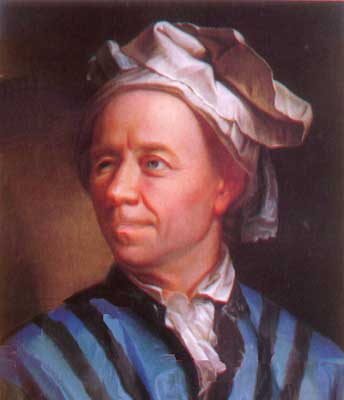Euler (1770)

Most prolific mathematician of all time, 13 children. Liked to make his own hats.
- Found a
closed form for the sum of the infinite series
 (2) =
(2) =
 (1/n2). This is
generalized from the famous harmonic series.
(1/n2). This is
generalized from the famous harmonic series.  is of
course zeta.
is of
course zeta.
- Euler
showed in 1735 that
 (2) = p2/6
(rationals <---> irrationals)
(2) = p2/6
(rationals <---> irrationals)
- Euler proved the connection of the zeta function with the series of prime numbers giving the famous relation
![]() (s) =
(s) = ![]() (1/ns) =
(1/ns) = ![]() (1 - p-s)-1
(1 - p-s)-1
Here the sum is over all natural numbers n while the product is over all prime numbers.
- Euler studied it for integral powers of s.
- (1,0 for arithmetic, p for geometry, i for algebra, e for analysis)
Aside1: Fermat conjectured 2 2^n+1
is prime (called Fermat numbers), Euler
factored 232 +1. Basis: If not prime a factor existed would
have to be of the form 2(5+1)k+1 or 64k+1
Only a few need be checked, proved not prime with 641 a Carmichael
Number.
He could also have checked via division of the number of primes
up to
64K, (6,500 trial divisions, primes found by the Sieve of
Eratosthenes)
Aside2: Euler
partitioned 1,000,009 into 10002 +32 and 9722
+2352 and thereby also producing factors of 3413 and
293. He did this when he was in his 70s and had been blind for 10 years.
Aside3: Laplace told his students, "Liesez Euler, Liesez Euler, c'est
notre maître
à tous" ("Read Euler, read Euler, he is our master in
everything")
Back Continue